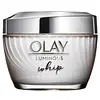What's inside
What's inside
 Key Ingredients
Key Ingredients

 Benefits
Benefits

 Concerns
Concerns

 Ingredients Side-by-side
Ingredients Side-by-side

Water
Skin ConditioningVinyl Dimethicone/Methicone Silsesquioxane Crosspolymer
Glycerin
HumectantNiacinamide
SmoothingIsohexadecane
EmollientIsopropyl Isostearate
EmollientPanthenol
Skin ConditioningCamellia Sinensis Leaf Extract
AntimicrobialDimethicone
EmollientStearyl Alcohol
EmollientSodium Polyacrylate Starch
AbsorbentCetyl Alcohol
EmollientCaprylyl Glycol
Emollient1,2-Hexanediol
Skin ConditioningPhenoxyethanol
PreservativeInositol
HumectantBehenyl Alcohol
EmollientDimethiconol
EmollientPEG-100 Stearate
Parfum
MaskingCetearyl Glucoside
EmulsifyingCetearyl Alcohol
EmollientStearic Acid
CleansingPalmitic Acid
EmollientBHT
AntioxidantDisodium EDTA
Zinc Gluconate
Skin ConditioningMagnesium Aspartate
Skin ConditioningCopper Gluconate
Skin ConditioningWater, Vinyl Dimethicone/Methicone Silsesquioxane Crosspolymer, Glycerin, Niacinamide, Isohexadecane, Isopropyl Isostearate, Panthenol, Camellia Sinensis Leaf Extract, Dimethicone, Stearyl Alcohol, Sodium Polyacrylate Starch, Cetyl Alcohol, Caprylyl Glycol, 1,2-Hexanediol, Phenoxyethanol, Inositol, Behenyl Alcohol, Dimethiconol, PEG-100 Stearate, Parfum, Cetearyl Glucoside, Cetearyl Alcohol, Stearic Acid, Palmitic Acid, BHT, Disodium EDTA, Zinc Gluconate, Magnesium Aspartate, Copper Gluconate
Alcohol
AntimicrobialWater
Skin ConditioningBenzyl Alcohol
PerfumingBeta-Carotene
Skin ConditioningCamellia Sinensis Leaf Extract
AntimicrobialCeramide Ns
Skin ConditioningCeteareth-20
CleansingCetearyl Alcohol
EmollientCetearyl Glucoside
EmulsifyingCitrus Reticulata Peel Oil
MaskingCyclohexasiloxane
EmollientCyclopentasiloxane
EmollientDaucus Carota Sativa Root Extract
Skin ConditioningDisodium EDTA
Ethylhexylglycerin
Skin ConditioningGlycerin
HumectantGlycine Soja Oil
EmollientHydroxyethylcellulose
Emulsion StabilisingIsopropyl Myristate
EmollientLecithin
EmollientMorinda Citrifolia Fruit Extract
Skin ConditioningPhenoxyethanol
PreservativePotassium Sorbate
PreservativePropylene Glycol
HumectantPrunus Amygdalus Dulcis Oil
Skin ConditioningSodium Ascorbyl Phosphate
AntioxidantSodium Benzoate
MaskingTocopherol
AntioxidantTocopheryl Acetate
AntioxidantUbiquinone
AntioxidantXanthan Gum
EmulsifyingAscorbic Acid
AntioxidantAlcohol, Water, Benzyl Alcohol, Beta-Carotene, Camellia Sinensis Leaf Extract, Ceramide Ns, Ceteareth-20, Cetearyl Alcohol, Cetearyl Glucoside, Citrus Reticulata Peel Oil, Cyclohexasiloxane, Cyclopentasiloxane, Daucus Carota Sativa Root Extract, Disodium EDTA, Ethylhexylglycerin, Glycerin, Glycine Soja Oil, Hydroxyethylcellulose, Isopropyl Myristate, Lecithin, Morinda Citrifolia Fruit Extract, Phenoxyethanol, Potassium Sorbate, Propylene Glycol, Prunus Amygdalus Dulcis Oil, Sodium Ascorbyl Phosphate, Sodium Benzoate, Tocopherol, Tocopheryl Acetate, Ubiquinone, Xanthan Gum, Ascorbic Acid
Ingredients Explained
These ingredients are found in both products.
Ingredients higher up in an ingredient list are typically present in a larger amount.
Camellia Sinensis Leaf Extract is derived from the leaves of the tea plant. Black tea, green tea, and oolong tea are all harvested from this plant.
This ingredient has many skin benefits:
This ingredient contains polyphenols, a strong antioxidant. Antioxidants help fight off molecules that damage skin cells.
On top of that, the antioxidants in green tea neutralize free-radicals from the sun. This gives the skin some extra UV protection, but should not replace sunscreen.
Many components of tea have anti-inflammatory properties.
Polyphenols and L-theanine help soothe the skin and reduce irritation. The caffeine in Camellia Sinensis Leaf Extract helps calm inflamed blood vessels.
Other compounds found in tea include: Vitamin Bs, linoleic acid, magnesium, calcium, iron, and zinc.
Research has shown both drinking Camellia Sinensis Leaf Tea and applying it to the skin can help boost skin elasticity and hydration. Studies also show using tea extract may reduce sebum, or oil, production.
Learn more about Camellia Sinensis Leaf ExtractCetearyl alcohol is a mixture of two fatty alcohols: cetyl alcohol and stearyl alcohol. It is mainly used as an emulsifier. Emulsifiers help prevent the separation of oils and products. Due to its composition, it can also be used to thicken a product or help create foam.
Cetearyl alcohol is an emollient. Emollients help soothe and hydrate the skin by trapping moisture.
Studies show Cetearyl alcohol is non-toxic and non-irritating. The FDA allows products labeled "alcohol-free" to have fatty alcohols.
This ingredient is usually derived from plant oils such as palm, vegetable, or coconut oils. There is debate on whether this ingredient will cause acne.
Due to the fatty acid base, this ingredient may not be Malassezia folliculitis safe.
Learn more about Cetearyl AlcoholCetearyl Glucoside is a surfactant and emulsifier. It can be produced from synthetic of natural sources of cetearyl alcohol and glucose.
Emulsifiers help prevent ingredients from separating, such as oils and waters. It can also be used to enhance the texture of products.
As a surfactant, Cetearyl Glucoside helps during the cleansing process. By gathering all the dirt and oils, it allows these molecules to be washed away easily.
Learn more about Cetearyl GlucosideDisodium EDTA plays a role in making products more stable by aiding other preservatives.
It is a chelating agent, meaning it neutralizes metal ions that may be found in a product.
Disodium EDTA is a salt of edetic acid and is found to be safe in cosmetic ingredients.
Learn more about Disodium EDTAGlycerin is already naturally found in your skin. It helps moisturize and protect your skin.
A study from 2016 found glycerin to be more effective as a humectant than AHAs and hyaluronic acid.
As a humectant, it helps the skin stay hydrated by pulling moisture to your skin. The low molecular weight of glycerin allows it to pull moisture into the deeper layers of your skin.
Hydrated skin improves your skin barrier; Your skin barrier helps protect against irritants and bacteria.
Glycerin has also been found to have antimicrobial and antiviral properties. Due to these properties, glycerin is often used in wound and burn treatments.
In cosmetics, glycerin is usually derived from plants such as soybean or palm. However, it can also be sourced from animals, such as tallow or animal fat.
This ingredient is organic, colorless, odorless, and non-toxic.
Glycerin is the name for this ingredient in American English. British English uses Glycerol/Glycerine.
Learn more about GlycerinPhenoxyethanol is a preservative that has germicide, antimicrobial, and aromatic properties. Studies show that phenoxyethanol can prevent microbial growth. By itself, it has a scent that is similar to that of a rose.
It's often used in formulations along with Caprylyl Glycol to preserve the shelf life of products.
Water. It's the most common cosmetic ingredient of all. You'll usually see it at the top of ingredient lists, meaning that it makes up the largest part of the product.
So why is it so popular? Water most often acts as a solvent - this means that it helps dissolve other ingredients into the formulation.
You'll also recognize water as that liquid we all need to stay alive. If you see this, drink a glass of water. Stay hydrated!
Learn more about Water